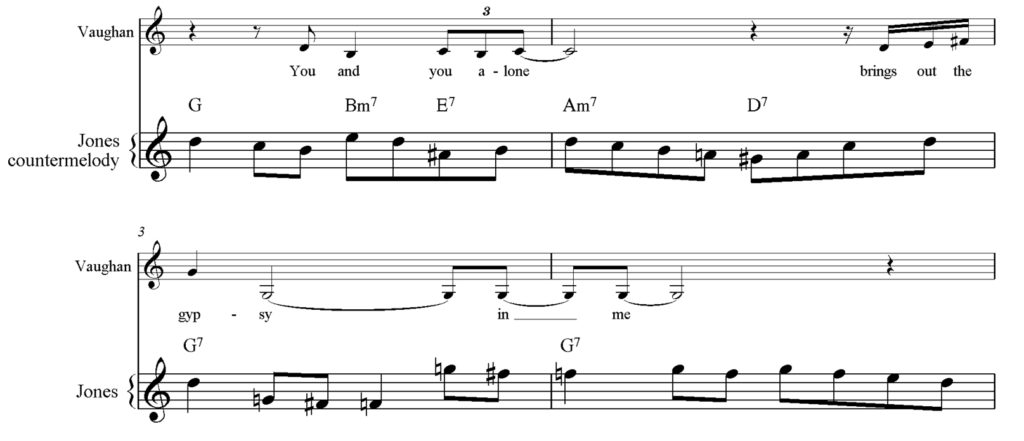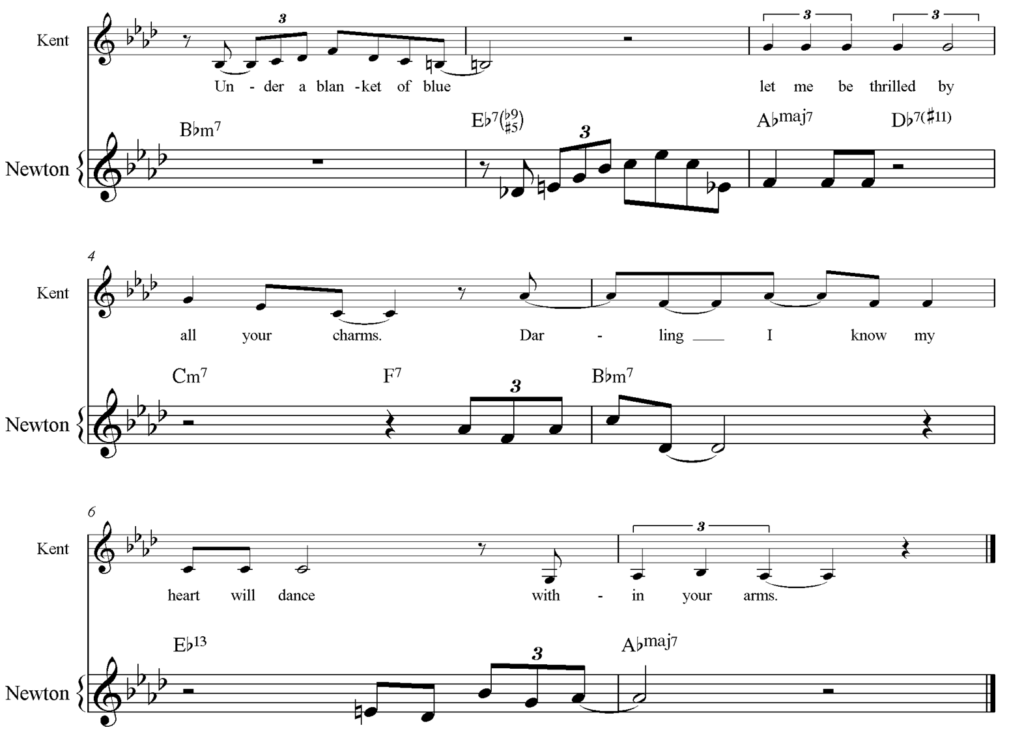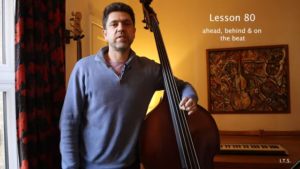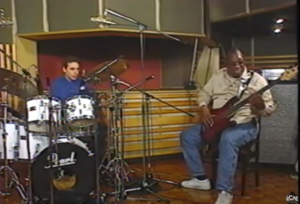CHAPTER 8: ORNAMENTATION(装飾)
Ornamentation – adding fills(装飾 - フィルの追加)
At its highest level, the soloist / accompanist relationship is a collaborative effort. A conversational, interactive performance is the norm in jazz. Musicians often achieve a dialogue through call-and-response elements including accompaniment fills and ornamentation of the melody. To achieve variety, accompanists alternate single-note line fills, thirds and other chordal interjections between the vocalist’s phrases. Additionally, the accompanist can create countermelodies underneath the vocalist’s original melodic phrases. The use of each device is a matter of taste and spontaneity. Yet, as always, the accompanist should continually keep the focus on the vocalist.
最高水準のソリストと伴奏者の関係は、共同の努力です。ジャズでは、会話的でインタラクティブな演奏が一般的です。ミュージシャンは、伴奏のフィルやメロディの装飾を含む応答や呼びかけの要素を通じて対話を実現することがよくあります。バラエティを出すために、伴奏者はヴォーカリストのフレーズの間にシングルノートのラインフィルやサード、他のコード的な間奏を交互に使用することがあります。さらに、伴奏者はヴォーカリストのオリジナルのメロディフレーズの下に対旋律を作り出すことができます。これらの手法の使用は好みや即興性の問題です。しかし、常に伴奏者はヴォーカリストに焦点を置くよう心がけるべきです。
In a 2005 interview, Hank Jones pointed out the variety in Jimmy Jones’s accompaniment of Sarah Vaughan on “Embraceable You” from Sarah Vaughan With Clifford Brown. Hank mentioned Jimmy’s use of a soft harmonic background and continuous countermelodies.56 He noted that Vaughan probably liked the single-note fills that Jimmy provided.57 However in his estimation, Hank Jones observed: “If you do that, you run the risk of interfering with the singer’s train of thought. But I think Sarah liked the pianist to lead the train of thought and for her to follow.”58 Such counter-lines would not distract a seasoned performer like Vaughan, and were hence effective. The following passage illustrates Jimmy Jones’s approach:
2005年のインタビューで、ハンク・ジョーンズは、ジミー・ジョーンズがサラ・ヴォーンと共演した「Embraceable You」(アルバム「Sarah Vaughan With Clifford Brown」収録)での伴奏における多様性について指摘しました。ハンクは、ジミーが柔らかい和声の背景と継続的な対旋律を使用していることに言及しました。彼はまた、ジミーが提供するシングルノートのフィルをヴォーンがおそらく気に入っていたのだろうと述べました。しかし、ハンク・ジョーンズの評価では、「それをすると、歌手の思考の流れを妨げるリスクがある。ただし、私はサラがピアニストが思考の流れをリードし、彼女がそれに続くことを好んだのだと思う。」と指摘しました。そのような対旋律は、ヴォーンのようなベテランのパフォーマーには気を散らすことはなく、むしろ効果的でした。以下のパッセージは、ジミー・ジョーンズのアプローチを示しています。
Example 8.1. Jimmy Jones’s accompaniment of Sarah Vaughan on “Embraceable You” (George and Ira Gershwin, 1930).

Sarah Vaughan with Jimmy Jones Trio / SARAH VAUGHAN - Embraceable You
Though Jones is playing a virtually continuous stream of eighth notes in this example and throughout much of his accompaniment on this track, his touch is light and the fills are mostly in a higher register. In this unobtrusive way he never obscures Vaughan’s vocal line. This approach also allows for subtle harmonic implications. For example, Jones uses a sharp eleven in Example 8.1 on the chords E7 and D7 to add color to Vaughan’s melody.
ジョーンズは、この例やこのトラックの彼の伴奏のほとんどでほぼ連続した8分音符の流れを演奏していますが、彼のタッチは軽く、フィルは主に高い音域で行われています。この控えめなアプローチにより、彼はヴォーンのボーカルラインを決して遮ることはありません。この方法は微妙な和声的な示唆も可能にします。例えば、ジョーンズは「Embraceable You」のE7とD7のコードで#11を使用し、ヴォーンのメロディにカラーを加えています。
Conversely, when asked about his own accompanying of Ella Fitzgerald, Hank Jones noted, “Ella’s preference was for block-chord fills, to make her feel comfortable – never leading, always playing in response to her.”59 Ella liked this style because she was a very rhythmic singer, in addition to being a good ballad singer, and “the rhythmic block-chord approach helped her.”60
逆に、エラ・フィッツジェラルドとの共演について尋ねられた際、ハンク・ジョーンズは、「エラはブロックコードのフィルを好んでいました。彼女が快適に感じるために-常にリードせず、彼女に応じて演奏することが常でした。」と述べました。エラは非常にリズミカルな歌手であるだけでなく、バラード歌手でもあったため、このスタイルが彼女を助けたとハンクは言いました。「リズミカルなブロックコードのアプローチは彼女を助けました。」と彼は語っています。
The artists in this survey had differing opinions on the subject of ornamentation.
この調査対象のアーティストたちは、装飾に関する意見が異なっていました。
Halberstadt listens for holes between the vocal phrases to occasionally add fills. Sometimes he fills using the block-chord approach, and he notes that Milt Buckner conceived the style for piano, essentially importing the concept from the classic Basie saxophone soli style. However, if Halberstadt plays during these points of rest, he does so in a way that does not obscure the melody. He mentions it is unlikely that he would add single-note lines underneath a phrase, as Jimmy Jones did for Sarah Vaughan, because he feels it may distract the vocalist.
ハルバースタットは、ボーカルのフレーズ間に隙間があるときにフィルを追加することを目指しています。彼は時々ブロックコードのアプローチを使ってフィルを演奏することもあり、ミルト・バックナーが基本的にベースのサックソフォン・ソリ・スタイルからこのコンセプトを取り入れたことに触れています。ただし、ハルバースタットはメロディを覆い隠さないような演奏方法で休止のポイントで演奏するようにしています。彼は、ジミー・ジョーンズがサラ・ヴォーンのために行ったようにフレーズの下にシングルノートのラインを追加することは、ボーカリストを気を散らせる可能性があるため、しない傾向があると述べています。
John Colianni varies his fills through the use of form. On a standard AABA song like “Blue Skies” or “Sophisticated Lady,” Colianni might deploy single note lines on the second A section after using a chordal approach the first time around. However, in other instances he may sustain the same textures throughout an arrangement in order to maintain a uniform mood.
ジョン・コリアーニは、フォームを使用してフィルを変化させています。彼は「Blue Skies」や「Sophisticated Lady」などの標準的なAABAの曲では、最初のアラウンドではコードアプローチを使用した後、2番目のAセクションでシングルノートのラインを使用することがあります。ただし、他の場合には、一貫したムードを保つためにアレンジ全体で同じテクスチャーを維持することがあります。
Depending on the situation, Gunnison uses all of the approaches mentioned.
シチュエーションによって、グニソンは上記で言及されたアプローチをすべて使用します。
Like Halberstadt, he listens for the holes or points of minimal activity in the vocal line to punctuate the lines in order to complement the singer. Gunnison uses a balanced approach to his accompaniment of Carmen McRae on “Still We Dream” on Carmen Sings Monk. At many times on this ballad he holds a chord underneath each vocal phrase, and fill with single note lines, at 0:33, or employ chordal quartal planing, at 0:48.
ハルバースタットと同様に、彼はボーカルラインの最小限の活動点や穴を聴き、歌手を補完するためにラインを強調します。グニソンは、「Carmen Sings Monk」の「Still We Dream」でカルメン・マクレエの伴奏にバランスの取れたアプローチを使っています。このバラードの多くの箇所では、彼は各ボーカルフレーズの下に和音を保持し、0:33でシングルノートのラインでフィルするか、0:48でコードの四重奏のプレーニングを使います。
Carmen McRae / Carmen Sings Monk - Still We Dream
Jacob acknowledges that each vocalist has different tastes for fills and ornamentation, depending on the song. On the up-tempo rendition of “East of the Sun” on I’m With the Band, for example, his accompaniment of Sutton is almost entirely based on block-chord support. In other instances, as on the bluesy “Between the Devil and the Deep Blue Sea” from the same album, he tends to play more single-note interjections between Sutton’s phrases. In my own experience, block chord support is very effective at faster tempos.
ジェイコブは、歌手によって歌に合ったフィルや装飾の好みが異なることを認めています。例えば、彼がサットンと共演した「East of the Sun」のアップテンポバージョンでは、ほとんどの場合ブロックコードのサポートに基づいています。同じアルバムの「Between the Devil and the Deep Blue Sea」のようなブルージーな曲では、サットンのフレーズの間により多くのシングルノートの間奏を弾く傾向があります。個人的な経験から言えることは、ブロックコードのサポートはより速いテンポで非常に効果的であるということです。
Tierney Sutton / I'm With The Band - East of the Sun
Tierney Sutton / I'm With The Band - Between the Devil and the Deep Blue Sea
David Newton’s fills also vary according to the style and mood of the piece. On “Under a Blanket of Blue” on Dreamsville, he adds fills between Kent’s phrases, using swing-era vocabulary that is reminiscent of Oscar Peterson’s ornamentation behind Louis Armstrong on “Under a Blanket of Blue” on Ella and Louis. Though Newton’s style is similar to Peterson’s here, Newton states he was probably thinking more of Teddy Wilson at the time.61 Due to the exuberant, upbeat mood of the piece and because the guitar had more of a rhythm role, he felt more free to play actively with single note lines between Kent’s phrases. “It was a piece that “everybody knew” and could relax with,” he adds, and stresses, “such interjections must be musical at all times.” Complementing the vocalist’s phrases and lyrics results from careful listening and following. From 0:35 to 0:54 Newton provides a call-and-response dialogue that complements each vocal phrase:
デイビッド・ニュートンのフィルも、曲のスタイルやムードに応じて異なります。彼のアルバム「Dreamsville」の「Under a Blanket of Blue」では、ケントのフレーズの間にフィルを追加し、スイング時代の語彙を使用しています。これはオスカー・ピーターソンが「Ella and Louis」の「Under a Blanket of Blue」でルイ・アームストロングをバックアップする際の装飾を思わせるものです。ニュートンのスタイルはここでピーターソンに似ていますが、彼自身は当時はおそらくテディ・ウィルソンを意識していたと述べています。曲の陽気でアップビートなムードと、ギターがよりリズム的な役割を果たしていたことから、彼はケントのフレーズの間で積極的にシングルノートのラインを演奏する自由さを感じました。彼は「これはみんなが知っている曲で、リラックスして楽しめるものでした。」と付け加え、そして「こうした干渉は常に音楽的でなければなりません。」と強調しています。ヴォーカリストのフレーズと歌詞を補完するためには、注意深く聴き、追いかけることが重要です。0:35から0:54までの間、ニュートンは各ヴォーカルフレーズに対応する呼びかけと応答の対話を提供しています。
Example 8.2. David Newton’s fills on “Under a Blanket of Blue” (Livingston/Symes, 1933).

Stacey Kent / Dreamsville - Under a Blanket of Blue
Ella Fitzgerald · Louis Armstrong / Ella and Louis - Under a Blanket of Blue
In contrast to the single-note lines, Newton takes a block-chord accompaniment approach on “They Can’t Take That Away From Me” on Dreamsville. Though the tempo is only slightly slower than “Under a Blanket of Blue,” he chooses to play more sustained chords in conjunction with the guitar, adding very few single-note fills. The mood is more subdued, and the guitar plays a more prominent role, so Newton wisely plays with restraint. The guitar has the only solo and later plays the verse rubato with Kent.
「They Can’t Take That Away From Me」の場合、Newtonはシングルノート・ラインに対してブロック和音のアプローチを取っています。テンポは「Under a Blanket of Blue」とほぼ同じですが、ギターとの協調のため、ほとんどシングルノートのフィルを加えず、より持続的な和音を演奏しています。ムードはより抑制的で、ギターがより重要な役割を果たすため、Newtonは賢明に節制をもって演奏しています。ギターはソロを取り、後にケントと一緒にルバートでヴァースを演奏します。
Stacey Kent / Let Yourself Go:Celebrating Fred Astaire - They Can't Take That Away From Me
Laurence Hobgood notes that one must be careful about adding fills: ローレンス・ホブグッドは、フィルを追加することについて注意深くなる必要があると指摘しています。
Almost all Western music has a top (melody), middle (harmony) and bottom (bass line). People that are accompanying are spending most of their time in the middle. You are composing only part of the whole. You are shaping, building, sustaining, creating for the other two thirds. Anytime you are venturing into the top you better have a strong compositional reason. It shouldn’t just be an indulgence. You need to have the right kind of idea to put into that space.
ほとんどすべての西洋音楽には、上部(メロディ)、中間部分(ハーモニー)、下部(ベースライン)があります。伴奏者は主に中間部分で時間を費やしています。あなたが作曲するのは全体の一部分にすぎません。あなたは、他の2/3のために形作り、構築し、維持し、創造しています。上部に進む場合は、強い作曲的な理由がある必要があります。それは単なる自己満足ではなく、その空間に適したアイデアを持っている必要があります。
On “Easy Living” from Flirting With Twilight, at 1:50 after “maybe I’m a fool but it’s fun,” Hobgood fills the space with an improvised melody in parallel perfect fourth intervals, thereby complementing the modal harmony of this section of the piece.
「Flirting With Twilight」の「Easy Living」で、「maybe I’m a fool but it’s fun」の後の1:50で、ホブグッドは、並列の完全四度の即興メロディでスペースを埋め、この部分のモーダルハーモニーを補完しています。
Kurt Elling / Flirting With Twilight - Easy Living
In di Martino’s opinion, unless used as a special effect, too many fills detract from the focus of the singer. An extended fill, though, can be useful as an instrumental interlude to carry one section to another. The style of the tune affects how di Martino fills. For example, on the ballad “Blame it On My Youth” on Because of You, di Martino adds complementary single-note lines, fills in thirds and chordal interjections between Freddy Cole’s phrases. However on the bossa nova “All For You (Nuages)” on the same album, di Martino’s fills are more chordal and subdued.
ディ・マルティーノの考えでは、特別な効果として使われない限り、フィルを使いすぎると歌手の焦点がそがれてしまうとされています。ただし、長めのフィルは、一つのセクションから別のセクションに繋ぐための楽器の間奏曲として役立つことがあります。曲のスタイルによって、ディ・マルティーノがどのようなフィルをするかが異なります。例えば、「Because of You」のバラード「Blame it On My Youth」では、ディ・マルティーノはフレディ・コールのフレーズの間に補足的なシングルノートのラインを加え、サードでフィルをし、和音の挿入をします。しかし、同じアルバムのボサノバ「All For You (Nuages)」では、ディ・マルティーノのフィルはより和音的で抑え目です。
Freddy Cole / Because of You - Blame it On My Youth
Freddy Cole / Because of You - All For You
Larry Dunlap enjoys adding single-note line fills between vocal phrases, but tries to keep his lines simple and out of the vocalist’s range. Per Danielson advises that, above all, fills should be meaningful musical statements, noting that the accompanist must “make sure the phrases have a beginning and an end, and can stand by themselves as a musical phrase.”62 Furthermore, finding common stylistic elements, the singer’s “trademarks,” will help you to predict musically what is going to happen.63 In other words, it would be prudent to keep the fills in the style of the vocalist, and in my opinion, David Newton does this consistently well behind Stacey Kent.
ラリー・ダンラップは、ボーカルのフレーズの間にシングルノートのラインのフィルを加えることが好きですが、彼は自分のラインを簡単にして、ボーカリストの音域外に保とうとします。パー・ダニエルソンは、何よりも、フィルは意味のある音楽的な表現でなければならず、「伴奏者はフレーズに始まりと終わりがあることを確認し、それらが独立した音楽フレーズとして成立するようにしなければならない」と指摘しています。さらに、歌手の「特徴」であるスタイル上の共通点を見つけることで、音楽的に何が起こるかを予測するのに役立ちます。言い換えれば、ボーカリストのスタイルに合わせたフィルをすることが賢明であり、私の意見では、デイヴィッド・ニュートンはステイシー・ケントの後ろでこれを一貫してうまくやっています。
Much can be learned about effective ornamentation from the great singer/pianists of the past. Nat “King” Cole had impeccable taste when adding fills behind his own vocals. His fills have a sparkling, singing quality. Cole’s recording of “I Love You For Sentimental Reasons” on The World of Nat King Cole is particularly poignant. His rhythmic placement of block chords on “Route 66” and “It’s Only a Paper Moon” on the same album also offer exemplary models for accompaniment. They are sparse and tastefully used at key points of the phrase, and groove rhythmically. Looking beyond pianists, other excellent examples of complementary call-and-response interactions appear in historic recordings of Lester Young with Billie Holiday and John Coltrane with Johnny Hartman. Understanding, emulating and absorbing the various ornamenting styles of these masters should be the goal for the aspiring accompanist.
過去の偉大な歌手/ピアニストたちから、効果的な装飾について多くのことが学べます。ナット・“キング”・コールは、自分自身のボーカルの後ろにフィルを加える際に、完璧なセンスを持っていました。彼のフィルは、きらめくような歌うような質感があります。コールの「I Love You For Sentimental Reasons」の録音は、特に切ないものです。彼の「Route 66」と「It's Only a Paper Moon」のブロック・コードのリズムの配置も同じアルバムで素晴らしい伴奏のモデルを提供しています。彼らはフレーズの重要なポイントで疎に使われ、リズミカルにグルーブしています。ピアニストを超えて、ビリー・ホリデイとレスター・ヤング、ジョニー・ハートマンとジョン・コルトレーンなど、他の優れたコールアンドレスポンスの相互作用の例も、歴史的な録音に現れています。これらのマスターたちのさまざまな装飾スタイルを理解し、真似し、吸収することが、伴奏者志望者の目標であるべきです。
過去の偉大な歌手/ピアニストたちから、効果的な装飾について多くのことが学べます。ナット・“キング”・コールは、自分自身のボーカルの後ろにフィルを加える際に、完璧なセンスを持っていました。彼のフィルは、きらめくような歌うような質感があります。コールの「I Love You For Sentimental Reasons」の録音は、特に切ないものです。彼の「Route 66」と「It's Only a Paper Moon」のブロック・コードのリズムの配置も同じアルバムで素晴らしい伴奏のモデルを提供しています。彼らはフレーズの重要なポイントで疎に使われ、リズミカルにグルーブしています。ピアニストを超えて、ビリー・ホリデイとレスター・ヤング、ジョニー・ハートマンとジョン・コルトレーンなど、他の優れたコールアンドレスポンスの相互作用の例も、歴史的な録音に現れています。これらのマスターたちのさまざまな装飾スタイルを理解し、真似し、吸収することが、伴奏者志望者の目標であるべきです。
Nat King Cole / Get Your Kicks On - Route 66
Nat King Cole / It's Only A Paper Moon - It's Only a Paper Moon

